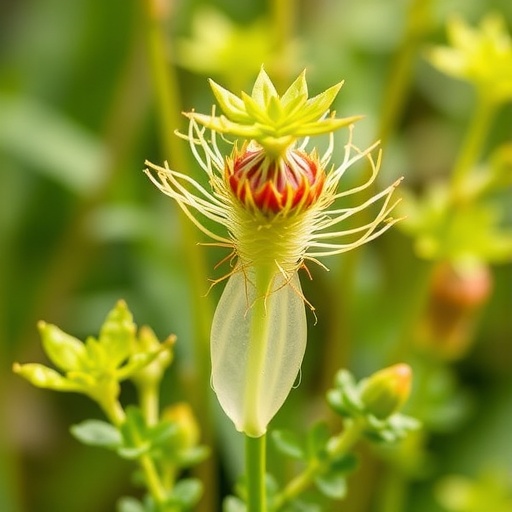In recent years, the intricate relationship between plants and their endophytic microbes has garnered increasing attention within the scientific community. A groundbreaking study led by Gore, Singh, and Swarnkar delves into this fascinating synergy, exploring how endophytes enhance plant defense mechanisms against pathogenic bacteria and fungi. This research signifies a pivotal moment in the field of plant pathology and microbiology, illuminating potential avenues for sustainable agriculture and plant protection.
At the core of this fascinating investigation is the notion that endophytes—microorganisms residing within the plant tissue without causing harm—play a critical role in fortifying plant resilience. These endophytic allies can produce an array of bioactive compounds that act as natural arsenals against microbial invaders. Their unique ability to mediate plant defense responses represents a significant step forward in understanding how plants interact with their microbiomes.
Gore et al. conducted a series of rigorous experiments to assess how these endophytic bacteria and fungi impact host plants’ susceptibility to various pathogens. By inoculating plants with selected endophytes, they observed marked enhancements in defensive phytochemicals, including phenolics and phytoalexins, which are known for their antimicrobial properties. The findings suggest that not only do these microbes aid in direct plant defense through biochemical pathways, but they also stimulate the plant’s physiological processes to evoke a heightened state of alert against future infections.
The implications of these findings extend far beyond the confines of academic interest; they hold profound relevance for agricultural practices. As global populations continue to swell, the demand for food production intensifies, often leading to increased pesticide usage to combat crop diseases. However, the application of endophyte-mediated defense strategies could pave the way for environmentally healthier agricultural practices, reducing reliance on chemical inputs and fostering biodiversity.
Particularly noteworthy is the discovery that certain endophytes can trigger systemic acquired resistance (SAR) in plants. This phenomenon allows plants to develop a more robust defense system, prepared to fend off a variety of pathogens after an initial encounter. The researchers noted that when certain endophytes were present, plants exhibited quicker and more effective responses upon pathogen attack, showcasing a remarkable evolutionary advancement.
Moreover, the study sheds light on the biodiversity of endophytes across different plant species and environmental contexts. While some endophytes are highly specific to particular plants, others demonstrate a broader adaptability, thriving in diverse ecological niches. This variability suggests a wealth of untapped potential in exploring endophyte relationships, creating opportunities for the discovery of novel microbial strains that could significantly benefit agricultural resilience.
In examining the genetic mechanisms underlying these endophyte-plant interactions, the researchers discovered an intricate web of signaling pathways activated in plants. The expression of genes related to stress responses, growth regulators, and secondary metabolite biosynthesis reveals an eloquent communication dialogue between host plants and their endophytes. Such insights could unlock further innovations in biotechnological applications geared toward enhancing crop resilience.
The study, published in the journal Discover Plants, demonstrates that endophytes could provide a dual benefit: enhancing plant health while simultaneously combating detrimental pathogens. As scientists and agronomists seek sustainable solutions to improve food security, the utilization of endophytes could lead to the development of bio-fertilizers and bio-pesticides, aligning with ecological farming practices.
Furthermore, the research prompts a reconsideration of traditional approaches toward disease management in crops. By integrating endophyte-assisted strategies into current agricultural frameworks, farmers could cultivate a more resilient crop system resistant to biotic and abiotic stresses. This progressive shift towards biocontrol methods, particularly in organic farming, could revolutionize how crops are grown, harvested, and protected.
In conclusion, the collaborative work of Gore, Singh, and Swarnkar exemplifies the potential of exploring endophytes as biocontrol agents in agriculture. The intricate interplay between these microbes and their plant hosts reveals a sophisticated defense mechanism that not only bolsters plant health but also offers a sustainable avenue for crop management. As this field of research continues to expand, it presents exciting possibilities for reshaping our agricultural landscapes, ensuring food security for future generations while minimizing environmental impacts.
This research also highlights the critical need for ongoing exploration and understanding of microbial communities associated with plants. The significance of endophytes underscores a broader narrative about the importance of maintaining microbial diversity in ecosystems, which can ultimately lead to resilient agricultural systems capable of withstanding the challenges posed by climate change and emerging pathogens.
The future of agricultural sustainability may well hinge on our ability to harness and understand the complexities of microbial interactions within plant systems. As researchers delve deeper into this exciting domain, the prospect for innovative practices that respect and utilize natural processes continues to glow on the horizon. Indeed, the journey into the microuniverse of plant endophytes has only just begun.
Subject of Research: Endophyte mediated plant defence responses and their potential against pathogenic bacteria and fungi.
Article Title: Endophyte mediated plant defence responses and their potential against pathogenic bacteria and fungi.
Article References: Gore, S., Singh, S., Swarnkar, P. et al. Endophyte mediated plant defence responses and their potential against pathogenic bacteria and fungi. Discov. Plants 2, 331 (2025). https://doi.org/10.1007/s44372-025-00429-4
Image Credits: AI Generated
DOI: https://doi.org/10.1007/s44372-025-00429-4
Keywords: Endophytes, plant defense, microbial interactions, sustainable agriculture, biocontrol, systemic acquired resistance, microbial biodiversity, environmental sustainability.
Tags: bioactive compounds in plantscombating plant pathogens with endophytesendophytes in plant defenseenhancing crop resistance to diseasesenhancing plant resilience with endophytesmicrobial interactions in agriculturenatural plant protection mechanismsphenolics and phytoalexins in plant defenseplant pathology and microbiologyrole of endophytes in phytochemistrysustainable agriculture practicessymbiotic relationships in plant-microbe interactions





